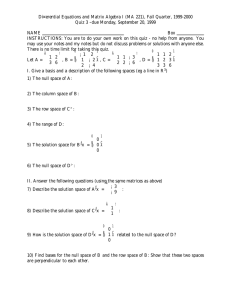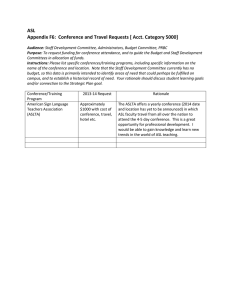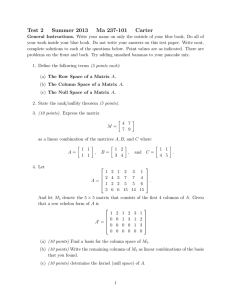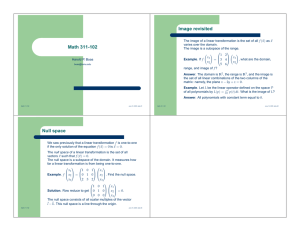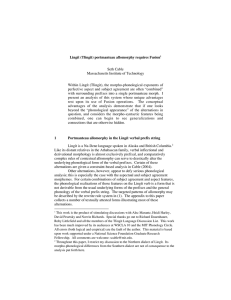Argument ellipsis in American Sign Language: When there is no... Sign languages (SL) grammaticalize the space utilized during utterance production:...
advertisement
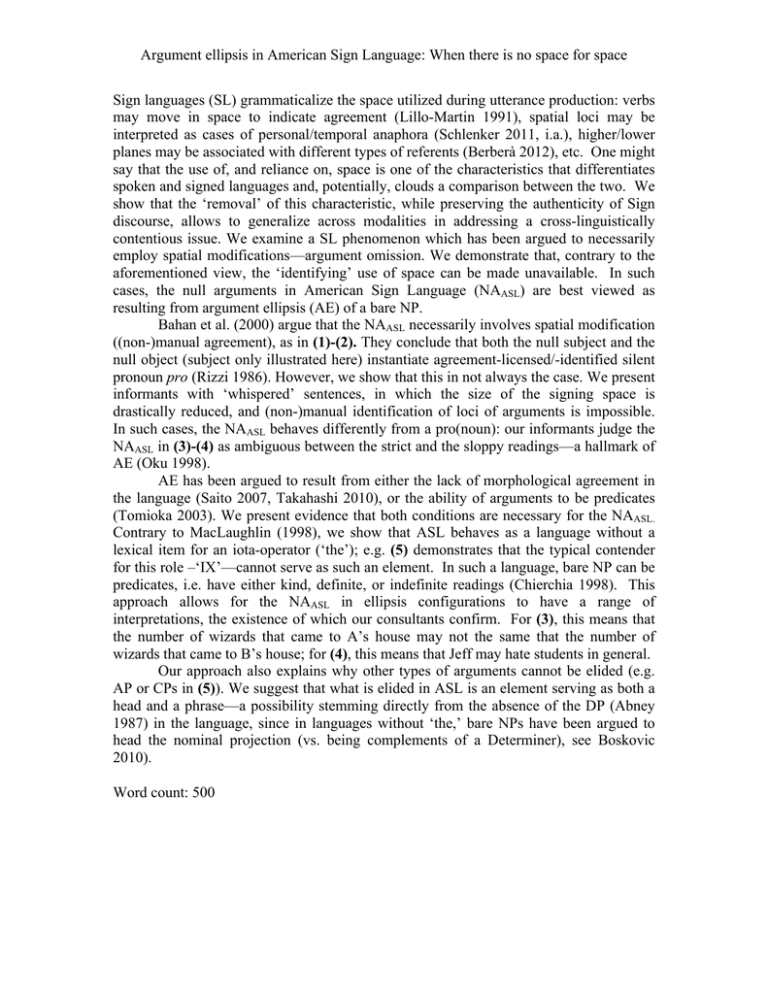
Argument ellipsis in American Sign Language: When there is no space for space
Sign languages (SL) grammaticalize the space utilized during utterance production: verbs
may move in space to indicate agreement (Lillo-Martin 1991), spatial loci may be
interpreted as cases of personal/temporal anaphora (Schlenker 2011, i.a.), higher/lower
planes may be associated with different types of referents (Berberà 2012), etc. One might
say that the use of, and reliance on, space is one of the characteristics that differentiates
spoken and signed languages and, potentially, clouds a comparison between the two. We
show that the ‘removal’ of this characteristic, while preserving the authenticity of Sign
discourse, allows to generalize across modalities in addressing a cross-linguistically
contentious issue. We examine a SL phenomenon which has been argued to necessarily
employ spatial modifications—argument omission. We demonstrate that, contrary to the
aforementioned view, the ‘identifying’ use of space can be made unavailable. In such
cases, the null arguments in American Sign Language (NAASL) are best viewed as
resulting from argument ellipsis (AE) of a bare NP.
Bahan et al. (2000) argue that the NAASL necessarily involves spatial modification
((non-)manual agreement), as in (1)-(2). They conclude that both the null subject and the
null object (subject only illustrated here) instantiate agreement-licensed/-identified silent
pronoun pro (Rizzi 1986). However, we show that this in not always the case. We present
informants with ‘whispered’ sentences, in which the size of the signing space is
drastically reduced, and (non-)manual identification of loci of arguments is impossible.
In such cases, the NAASL behaves differently from a pro(noun): our informants judge the
NAASL in (3)-(4) as ambiguous between the strict and the sloppy readings—a hallmark of
AE (Oku 1998).
AE has been argued to result from either the lack of morphological agreement in
the language (Saito 2007, Takahashi 2010), or the ability of arguments to be predicates
(Tomioka 2003). We present evidence that both conditions are necessary for the NAASL.
Contrary to MacLaughlin (1998), we show that ASL behaves as a language without a
lexical item for an iota-operator (‘the’); e.g. (5) demonstrates that the typical contender
for this role –‘IX’—cannot serve as such an element. In such a language, bare NP can be
predicates, i.e. have either kind, definite, or indefinite readings (Chierchia 1998). This
approach allows for the NAASL in ellipsis configurations to have a range of
interpretations, the existence of which our consultants confirm. For (3), this means that
the number of wizards that came to A’s house may not the same that the number of
wizards that came to B’s house; for (4), this means that Jeff may hate students in general.
Our approach also explains why other types of arguments cannot be elided (e.g.
AP or CPs in (5)). We suggest that what is elided in ASL is an element serving as both a
head and a phrase—a possibility stemming directly from the absence of the DP (Abney
1987) in the language, since in languages without ‘the,’ bare NPs have been argued to
head the nominal projection (vs. being complements of a Determiner), see Boskovic
2010).
Word count: 500
Argument ellipsis in American Sign Language: When there is no space for space
(1) a. Øi [+agri ]AgrS [+agrj ]AgrO iSHOOTj FRANKj
‘(He/She) shoots Frank.’
__________
_________
head tilt-i
eye gaze-j
b. Øi [+agri ]AgrS [+agrj] AgrO iSHOOTj FRANKj
(2) a. * Øi [+agri ]AgrS [+agrj ]AgrO LOVE MOTHERj
‘(He/She) loves mother.’
head tilt-i
b. Øi [+agri ]AgrS [+agrj]AgrO LOVE MOTHERj
(3) A: THREE WIZARDS COME VISIT MY HOUSE
‘Three wizards came to my house’
B: Ø STAY MY HOUSE ONE-WEEK.
‘ ({The samestrict/differentsloppy} wizards) stayed in my house for a week’
(4) a-PETER LIKE a-POSS STUDENT. b-JEFF HATE Ø
‘Peter likes his students. Jeff hates ({Peter’sstrict/Jeff’ssloppy} students)’
________t
_________________wh ?
(5) a. FRANCE (*IX) CAPITAL WHAT
‘What’s *(the) capital of France?’
(6) a. MARY FEEL HAPPY ABOUT neu-POSS TEST, PAUL NOT FEEL THAT/*Ø
‘Mary feels good about her test, Paul does not feel that’
b. MARY FELL TEACHER a-IX PREFER BOOK PAPER, PETER NOT FEEL THAT/*Ø
‘Mary feels that the teacher prefers paper-made books, but Peter does not feel that.’
References:
Bahan, B., Kegl, J., Lee, R. G., MacLaughlin, D., & Neidle, C. (2000). The licensing of
null arguments in ASL. LI, 31(1), 1-27.
Barberà Altimira, G. (2012) The meaning of space in Catalan Sign Language (LSC).
Reference, specificity and structure in signed discourse. PhD. Dissertation.
Universitat Pompeu Fabra.
Lilllo-Martin, D. (1991). Universal Grammar and American Sign Language: Setting the
Null Argument Parameters. Kluwer.
Oku, S. (1998). LF copy analysis of Japanese null arguments. Papers from the Regional
Meetings, CLS, 34(1), 299-314.
Tomioka, S. (2003). The semantics of Japanese null pronouns and its cross-linguistic
implications, in Schwabe, K. & S. Winkler (eds.) The Interfaces: Deriving and
Interpreting Omitted Structures. John Benjamins.
Schlenker, P. (2011) Temporal and Modal Anaphora in Sign Language (ASL). Paper
presented at FEAST1 Colloquium, Venice, Italy.

